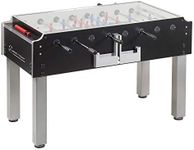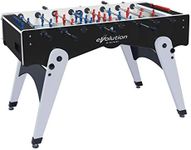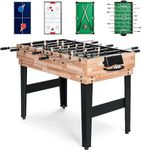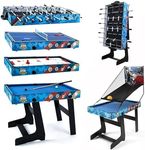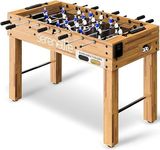Buying Guide for the Best Foosball Tables
Choosing the right foosball table can greatly enhance your playing experience, whether you're a casual player or a serious competitor. When selecting a foosball table, it's important to consider several key specifications to ensure you get the best fit for your needs. Understanding these specs will help you make an informed decision and enjoy your foosball games to the fullest.Table SizeTable size refers to the dimensions of the foosball table. This is important because it affects the space required to play and the overall playing experience. Standard full-size tables are around 56 inches long and 30 inches wide, providing ample space for competitive play. Smaller tables, such as those around 48 inches long, are more suitable for children or casual play in limited spaces. Choose a size that fits your available space and the level of play you desire.
Construction MaterialThe construction material of a foosball table determines its durability and stability. High-quality tables are often made from solid wood or composite materials, which offer excellent sturdiness and longevity. Mid-range tables might use MDF (medium-density fiberboard), which provides a good balance between cost and durability. Lower-end tables may use particleboard or plastic, which are less durable but more affordable. Consider how often and intensely the table will be used to decide on the appropriate material.
Rod TypeRods are the bars that players use to control the foosball men. They can be solid or hollow. Solid rods are heavier and provide more control, making them ideal for serious players. Hollow rods are lighter and allow for faster play, which can be more enjoyable for casual players. Additionally, telescopic rods, which do not protrude from the opposite side of the table, are safer for children. Choose the rod type based on your playing style and who will be using the table.
Playing SurfaceThe playing surface of a foosball table affects the speed and control of the game. High-end tables often feature a laminate or tempered glass surface, which provides a smooth and fast playing experience. Mid-range tables might have a melamine surface, which is also smooth but slightly slower. Lower-end tables may use a simple painted or stickered surface, which can be less consistent. Consider the level of play and the desired speed of the game when choosing the playing surface.
Goalie ConfigurationFoosball tables can have either a single goalie or a three-goalie configuration. A single goalie setup is more traditional and requires more skill to defend the goal, making it suitable for advanced players. A three-goalie setup is more common in the United States and provides easier defense, which can be more enjoyable for beginners and casual players. Decide on the goalie configuration based on your skill level and preference for gameplay.
Leg LevelersLeg levelers are adjustable feet on the table legs that allow you to ensure the playing surface is perfectly level. This is important for fair and consistent gameplay, as an uneven table can affect ball movement and player control. High-quality tables often come with built-in leg levelers, while lower-end tables may not. If you plan to place the table on an uneven floor, leg levelers are a crucial feature to look for.



